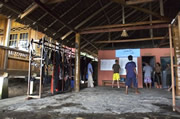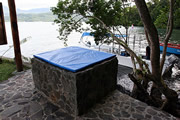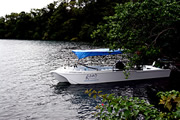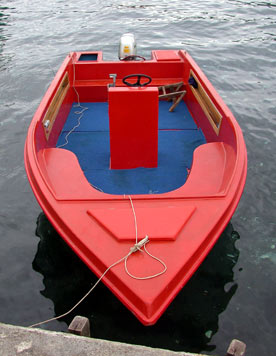![]()
![]()
![]()
Nomad Dive Centre

Nomad Dive Centre

Airy drying area for your wet equipment. You're assigned your own section for your equipment.

Dive briefings before every dive

Dunk tank for camera

Shower area for post-dive rinsing

The dive boat is big enough for giant stride entry, but you can choose to do backroll too if you prefer
In addition to the big dive boat, there're are two fibre-glass boats in case some divers in the group want to dive somewhere else.


AND BOTH HAVE A LADDER.
Even then, it's best to take off everything before climbing into the boat after your dive. The lowest rung is still quite high, and it'll be much easier without the heavyweight tank on your back.
The good news is you don't have to leave your fins on, and do the fin-till-the-bouyancy-lifts-you thing.

The Nomad Dive Centre is staffed by:
* This information was when we last went in July 2007. As the community of dive guides and dive boat crew in Lembeh is pretty small, some of these names may now belong to other resorts, with new ones in their place :-)
The dive centre runs as smoothly as a first-class Swiss timepiece. There is a large noticeboard showing the boat, guides, site and time for every single dive, another board showing a map of the dive sites, and you can request copies of the dive site map to keep. You are also assigned your own open-locker (with your name on it!!!) for your dive equipment. Have I mentioned that I get a big thrill from well-organised places?
Dive Briefings
Dive briefings take place first at the dive centre before you board the boat, and then on the boat at the dive site. The briefing basically gives you essential information about the dive site (eg white or black sand, sloping or flat, general route) and the marine life you might see. The guide will also draw out the site on a little white board for you to get a clearer picture of your dive. Generally though, if you have specific questions to ask, like is there a current and how strong it is, just ask, rather than wait passively for the information.
The most practical thing to do when diving in Lembeh, is to follow your guide. In this way, you will see the best that the Lembeh Straits has to offer, you will not get lost, and you will not have to huff and puff a hundred metres back to the boat after surfacing.
At Nomad Adventure Divers, the dive-guest ratio is never more than 4 guests per guide. When we went in March 2007, Elrick was our guide. Elrick was amazingly patient, will light your subject for as long as it takes for you to photograph it, and will help you master the digital Nitrox analyser. He has eyes in the back of his head because he kept an eye on all 3 of us, 2 being photographers, when we were all in different places. He knows exactly where the resident anglerfish, seahorses and other favourites are. He's also young and good-looking :-)
When we went in July 2007, our guide was Yopie. For his 25 years, he was a very experienced guide who even discovered one of the mandarin dive sites (Tanjong Kusu Kusu). He valiantly pointed out a tiny critter even though he was shivering in his shortie at the end of the dive in 26-degree water, while you calmly take a million pictures wearing your 3 layers. He also had a great collection of football jerseys and black heavy metal / hard rock t-shirts. His birthday was on 29 July. We all miss you Yopie.
A lot of the staff are related to one another.
The boat crew and guides will:
Chivalry meter: SUPER EXCELLENT

On our last day, the crew moved our entire dive setup into the sun so they would dry in time for our return flight home
This is an abridged version of what I said in the SDQ pages, just in case you don't read those pages, because I really want everyone to know how nice Lembeh Straits is.
There are two dives in the morning, and one in the afternoon. During the surface interval for the morning dives, it's lovely to just nap under the sun on the front deck or the roof of the boat. And because they usually lower the ladder during the surface interval, you can also take the occasional dip (or pee) in the calm water.
Rain is usually just a passing shower, and over in minutes. Under the sun, the surface intervals are long enough for your towels and swimsuit to dry to a nice warm toasty state. Which just about encapsulates the essence of Sulawesi - do what you have to do, but take time to nap in the sun, and everything will turn out nice and toasty. Because in Sulawesi time slows down, you feel yourself relaxing, and then you start feeling like you should drop your career, go live in Sulawesi where you can dive every weekend, and fill your weekdays doing something noble like teach.
Before you scroll down, do note that the times below are more or less fixed. However, if the resort isn't packed to the brim, the times can be a little more flexible. If you are having a blast at lunchtime listening to a guest's hilarious story, then the next dive can wait. If a fellow diver has twice your lung capacity and goes on 1.5 hour dives, then the surface intervals are understandably longer and your next dive is understandably later. Here, the guest decides.
7.00am Wake up because the sun is shining in your room. Set up camera and do really important things like go to the toilet, brush your teeth, put on contact lenses, put on sunblock lotion.
7.30 Breakfast
7.50 Return to room. Sit on throne if necessary. Wash up. Test camera.
8.20 Dunk camera and check for leaks. Attend dive briefing, board boat, check that all equipment is there.
8.30 Embark for two morning dives. You can put on your wetsuit on the boat and analyse your Nitrox tank on the way to the divesite.
1.00pm - Return for lunch. Return to room first to rinse off (there is time to shower and condition your hair). Charge strobe.
1.30pm Lunch
2.00 Return to room for quick nap.
2.45 Wake up. Test and dunk camera.
3.00 Embark for one afternoon dive.
5.00 or thereabouts Return to room. Rinse off (shower and condition). Take nap.
5.45 Wake up. Test and dunk camera.
6.00 Embark for night dive
7.45 Return to resort. Have shower, change, and go for dinner.
Note: If you opt for the Mandarinfish dive, it will start about 5.15pm because the peak mating period is at about 5.45pm. There is unlikely to be a night dive after that.